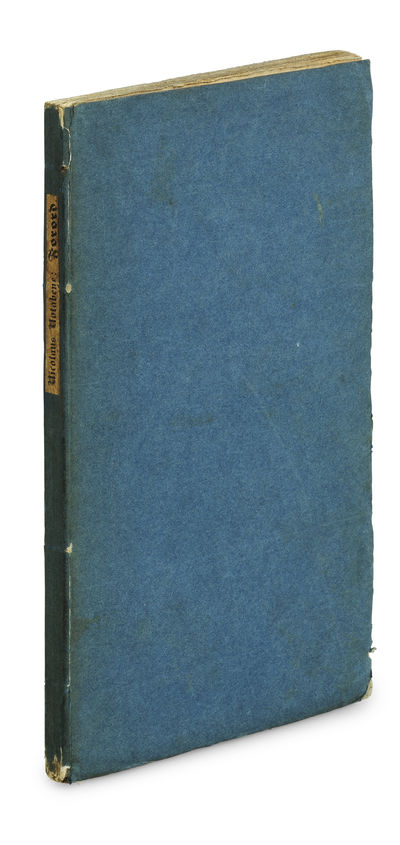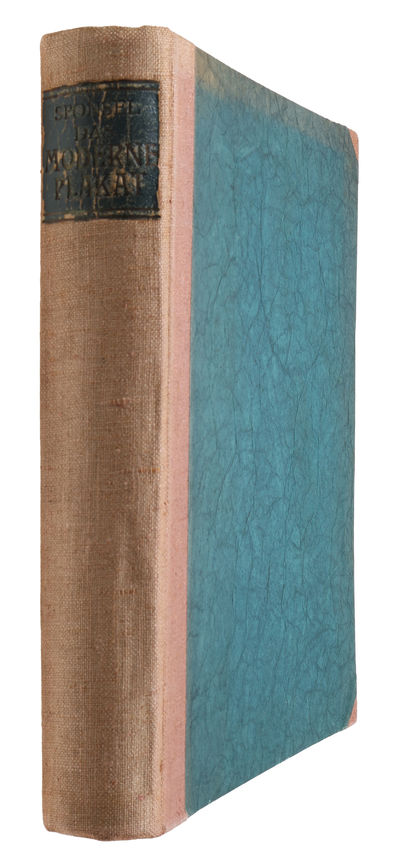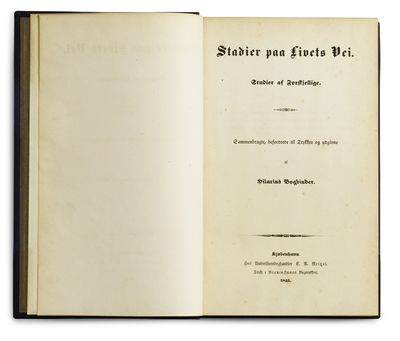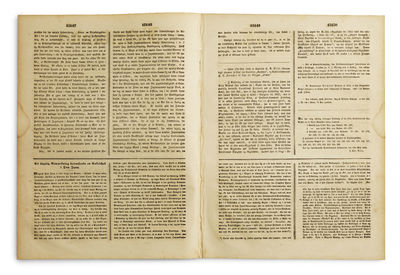KIERKEGAARD, SØREN.
Om Begrebet Ironi med stadigt hensyn til Socrates. Af S. A. Kierkegaard. - [PRESENTATION-COPY TO HIS PREVIOUS GREEK TEACHER BOJESEN]
Herman H. J. Lynge & Søn A/S
lyn62108
Kjøbenhavn, P.G. Philipsens Forlag, 1841. 8vo. (8), 350 pp. Gift binding of plain brown full cloth with single gilt lines to spine. Printed on fine paper. Handwritten title to spine: “Kierkegaard / Om / Ironie”. Very neat, barely noticeable small restorations to capitals and to corners. A bit of browning and brownspotting, mostly to the first leaves. With the ex libris of Georg Nygaard to inside of front board and pencil annotation stating that the copy was bought at the auction of his collection in 1943, by bookseller Hagerup.
Magnificent presentation-copy of Kierkegaard's dissertation, inscribed toverso of front fly-leaf to his previous Greek teacher, Bojesen: “Til / Hr. Professor Boiesen” (i.e. For / Mr. Professor Boiesen). The copy is with the Thesis, but neither the date nor the time has been filled in by hand as usual in the presentation-copies. This is presumably because he did not expect his previous teacher to show up to the defense. Kierkegaard's dissertation constitutes the culmination of three years’ intensive studies of Socrates and “the true point of departure for Kierkegaard’s authorship” (Brandes). The work is of the utmost importance in Kierkegaard’s production, not only as his first academic treatise, but also because he here introduces several themes that will be addressed in his later works. Among these we find the question of defining the subject of cognition and self-knowledge of the subject. The maxim of “know thyself” will be a constant throughout his oeuvre, as is the theory of knowledge acquisition that he deals with here. The dissertation is also noteworthy in referencing many of Hegel’s theses in a not negative context, something that Kierkegaard himself would later note with disappointment and characterize as an early, uncritical use of Hegel. Another noteworthy feature is the fact that the thesis is written in Danish, which was unheard of at the time. Kierkegaard felt that Danish was a more suitable language for the thesis and hadto petition the King to be granted permission to submit it in Danish rather than Latin. This in itself poses as certain irony, as the young Kierkegaard was known to express himself poorly and very long-winded in written Danish. One of Kierkegaard’s only true friends, his school friend H.P. Holst recounts (in 1869) how the two had a special school friendship and working relationship, in which Kierkegaard wrote Latin compositions for Holst, while Holst wrote Danish compositions for Kierkegaard, who “expressed himself in a hopelessly Latin Danish crawling with participial phrases and extraordinarily complicatedsentences” (Garff, p. 139). When Kierkegaard, in 1838, was ready to publish his famous piece on Hans Christian Andersen (see nr. 1 & 2 above), which was to appear in Heiberg’s journal Perseus, Heiberg had agreed to publish the piece, although he had some severe critical comments about the way and the form in which it was written – if it were to appear in Perseus, Heiberg demanded, at the very least, the young Kierkegaard would have to submit it in a reasonably readable Danish. “Kierkegaard therefore turned to his old schoolmate H. P. Holst and asked him to do something with the language…” (Garff, p. 139). From their school days, Holst was well aware of the problem with Kierkegaard’s Danish, and he recounts that over the summer, he actually “translated” Kierkegaard’s article on Andersen into proper Danish. The oral defense was conducted in Latin, however. The judges all agreed that the work submitted was both intelligent and noteworthy. But they were concerned about its style, which was found to be both tasteless, long-winded, and idiosyncratic. We already here witness Kierkegaard’s idiosyncratic approach to content and style that is so characteristic for all of his greatest works. Both stylistically and thematically, Kierkegaard’s and especially a clear precursor for his magnum opus Either-Or that is to be his next publication. In many ways, Either-Or is born directly out of The Concept of Irony and is the work that brings the theory of Irony to life. Part One of the dissertation concentrates on Socrates as interpreted by Xenophon, Plato, and Aristophanes, with a word on Hegel and Hegelian categories. Part Two is a more synoptic discussion of the concept of irony in Kierkegaard’s categories, with examples from other philosophers. The work constitutes Kierkegaard’s attempt at understanding the role of irony in disrupting society, and with Socrates understood through Kierkegaard, we witness a whole new way of interpreting the world before us. Wisdom is not necessarily fixed, and we ought to use Socratic ignorance to approach the world without the inherited bias of our cultures. With irony, we will be able to embrace the not knowing. We need to question the world knowing we may not find an answer. The moment we stop questioning and just accept the easy answers, we succumb to ignorance. We must use irony to laugh at ourselves in order to improve ourselves and to laugh at society in order to improve the world. The work was submitted to the Philosophical Faculty at the University of Copenhagen on June 3rd 1841. Kierkegaard had asked for his dissertation to be ready from the printer’s in ample time for him to defend it before the new semester commenced. This presumably because he had already planned his sojourn to Berlin to hear the master philosopher Schelling. On September 16th, the book was issued, and on September 29th, the defense would take place. The entire defense, including a two hour long lunch break, took seven hours, during which ”an unusually full auditorium” would listen to the official opponents F.C. Sibbern and P.O. Brøndsted as well as the seven “ex auditorio” opponents F.C. Petersen, J.L. Heiberg, P.C. Kierkegaard, Fr. Beck, F.P.J. Dahl, H .J.Thue og C.F. Christens, not to mention Kierkegaard himself. The work appeared in two states – one with the four pages of “Theses”, for academics of the university, whereas the copies without the theses were intended for ordinary sale. These sales copies also do not have “Udgivet for Magistergraden” and “theologisk Candidat” on the title-page. The first page of the theses always contains the day “XXIX” of September written in hand, and sometimes the time “hora X” is also written in hand, but not always. In all, 11 presentation-copies of the dissertation are known, and of these only one is signed (that for Holst), all the others merely state the title and name of the recipient. As is evident from the auction catalogue of his collection, Kierkegaard had a number of copies of his dissertation in his possession when he died. Five of them were bound, and two of them were “nit. M. Guldsnit” (i.e. daintily bound and with gilt edges). These two copies were obviously meant as presentation-copies that he then never gave away. The gift copies of the dissertation were given two types of bindings, both brownish cloth, one type patterned, the other one plain, and some of them have gilt edges, but most of the plain ones do not. There exist two copies on thick vellum paper – one being Kierkegaard’s own copy, the other being the copy for H.C. Ørsted, discoverer of electromagnetism and then principle of the University of Copenhagen. “As already implied, two works of the authorship stand out in the sense that Kierkegaard sent his presentation-copies to a special circle of people: The dissertation from 1841...” (Posselt, Textspejle, p. 91, translated from Danish). Most of the copies were given to former teachers and especially to people who, due to leading positions, personified the university. “For this circle of initiated we can now, due to registered copies, confirm that Kierkegaard gave copies with handwritten dedications to the headmaster of the University H.C. Ørsted (printed on thick paper), Kolderup-Rosenvinge and to J.L. Heiberg. It is granted that Sibbern, Madvig and F.C. Petersen were also given the dissertation as a gift,... but these copies are not known (yet).” (Posselt, Textspejle, pp. 93-94, translated fromDanish). (N.b. We have since handled the copy given to Petersen and can thus confirm that it exists). The presentation-inscriptions in the 11 registered copies of the Irony all follow a certain, strict pattern. “The wording could not be briefer. In the donation of his academic treatise, the otherwise prolific Kierkegaard sticks to name, titles, and the modes of address that goes with the titles.” (Tekstspejle p. 96, translated from Danish). When presenting his later books, he always signs himself “from the author”, sometimes abbreviated (i.e. “Forf.” In stead of “Forfatteren”), unless he is mentioned by name on the title-page as the publisher, not the author, as is the case with some of the pseudonymous works. In that case he signs his inscriptions “From the publisher”, always accompanied by “in deep reverence”, “with reverence”, “with friendship” or the like, adapted to the rank of the recipient and his place on Kierkegaard’s personal scale. An academic treatise, however, published before the oral defense took place – in the mind of Kierkegaard – required certain demands in relation to the donation of it. Thus, the brevity and rigidity in the inscriptions. Ernst Frederik Christian Bojesen (1803-64) was a philologist and school man. In 1820, Bojesen graduated as student from Borgerdydskolen, where he already the following year began teaching classical languages and soon became the principal’s right hand man. Here, he taught classical languages and was Kierkegaard’s teacher of classical Greek. He later became dr. Phil and professor at Sorø Akademi, where “in September 1841, he received, by post, a presentation-copy of the dissertation “On the Concept of Irony” by his previous disciple. (Tudvad, Kierkegaards København, p. 171). Himmelstrup 8 The present copy is no. 7 in Girsel's "Kierkegaard" (The Catalogue) which can be found here.
Magnificent presentation-copy of Kierkegaard's dissertation, inscribed toverso of front fly-leaf to his previous Greek teacher, Bojesen: “Til / Hr. Professor Boiesen” (i.e. For / Mr. Professor Boiesen). The copy is with the Thesis, but neither the date nor the time has been filled in by hand as usual in the presentation-copies. This is presumably because he did not expect his previous teacher to show up to the defense. Kierkegaard's dissertation constitutes the culmination of three years’ intensive studies of Socrates and “the true point of departure for Kierkegaard’s authorship” (Brandes). The work is of the utmost importance in Kierkegaard’s production, not only as his first academic treatise, but also because he here introduces several themes that will be addressed in his later works. Among these we find the question of defining the subject of cognition and self-knowledge of the subject. The maxim of “know thyself” will be a constant throughout his oeuvre, as is the theory of knowledge acquisition that he deals with here. The dissertation is also noteworthy in referencing many of Hegel’s theses in a not negative context, something that Kierkegaard himself would later note with disappointment and characterize as an early, uncritical use of Hegel. Another noteworthy feature is the fact that the thesis is written in Danish, which was unheard of at the time. Kierkegaard felt that Danish was a more suitable language for the thesis and hadto petition the King to be granted permission to submit it in Danish rather than Latin. This in itself poses as certain irony, as the young Kierkegaard was known to express himself poorly and very long-winded in written Danish. One of Kierkegaard’s only true friends, his school friend H.P. Holst recounts (in 1869) how the two had a special school friendship and working relationship, in which Kierkegaard wrote Latin compositions for Holst, while Holst wrote Danish compositions for Kierkegaard, who “expressed himself in a hopelessly Latin Danish crawling with participial phrases and extraordinarily complicatedsentences” (Garff, p. 139). When Kierkegaard, in 1838, was ready to publish his famous piece on Hans Christian Andersen (see nr. 1 & 2 above), which was to appear in Heiberg’s journal Perseus, Heiberg had agreed to publish the piece, although he had some severe critical comments about the way and the form in which it was written – if it were to appear in Perseus, Heiberg demanded, at the very least, the young Kierkegaard would have to submit it in a reasonably readable Danish. “Kierkegaard therefore turned to his old schoolmate H. P. Holst and asked him to do something with the language…” (Garff, p. 139). From their school days, Holst was well aware of the problem with Kierkegaard’s Danish, and he recounts that over the summer, he actually “translated” Kierkegaard’s article on Andersen into proper Danish. The oral defense was conducted in Latin, however. The judges all agreed that the work submitted was both intelligent and noteworthy. But they were concerned about its style, which was found to be both tasteless, long-winded, and idiosyncratic. We already here witness Kierkegaard’s idiosyncratic approach to content and style that is so characteristic for all of his greatest works. Both stylistically and thematically, Kierkegaard’s and especially a clear precursor for his magnum opus Either-Or that is to be his next publication. In many ways, Either-Or is born directly out of The Concept of Irony and is the work that brings the theory of Irony to life. Part One of the dissertation concentrates on Socrates as interpreted by Xenophon, Plato, and Aristophanes, with a word on Hegel and Hegelian categories. Part Two is a more synoptic discussion of the concept of irony in Kierkegaard’s categories, with examples from other philosophers. The work constitutes Kierkegaard’s attempt at understanding the role of irony in disrupting society, and with Socrates understood through Kierkegaard, we witness a whole new way of interpreting the world before us. Wisdom is not necessarily fixed, and we ought to use Socratic ignorance to approach the world without the inherited bias of our cultures. With irony, we will be able to embrace the not knowing. We need to question the world knowing we may not find an answer. The moment we stop questioning and just accept the easy answers, we succumb to ignorance. We must use irony to laugh at ourselves in order to improve ourselves and to laugh at society in order to improve the world. The work was submitted to the Philosophical Faculty at the University of Copenhagen on June 3rd 1841. Kierkegaard had asked for his dissertation to be ready from the printer’s in ample time for him to defend it before the new semester commenced. This presumably because he had already planned his sojourn to Berlin to hear the master philosopher Schelling. On September 16th, the book was issued, and on September 29th, the defense would take place. The entire defense, including a two hour long lunch break, took seven hours, during which ”an unusually full auditorium” would listen to the official opponents F.C. Sibbern and P.O. Brøndsted as well as the seven “ex auditorio” opponents F.C. Petersen, J.L. Heiberg, P.C. Kierkegaard, Fr. Beck, F.P.J. Dahl, H .J.Thue og C.F. Christens, not to mention Kierkegaard himself. The work appeared in two states – one with the four pages of “Theses”, for academics of the university, whereas the copies without the theses were intended for ordinary sale. These sales copies also do not have “Udgivet for Magistergraden” and “theologisk Candidat” on the title-page. The first page of the theses always contains the day “XXIX” of September written in hand, and sometimes the time “hora X” is also written in hand, but not always. In all, 11 presentation-copies of the dissertation are known, and of these only one is signed (that for Holst), all the others merely state the title and name of the recipient. As is evident from the auction catalogue of his collection, Kierkegaard had a number of copies of his dissertation in his possession when he died. Five of them were bound, and two of them were “nit. M. Guldsnit” (i.e. daintily bound and with gilt edges). These two copies were obviously meant as presentation-copies that he then never gave away. The gift copies of the dissertation were given two types of bindings, both brownish cloth, one type patterned, the other one plain, and some of them have gilt edges, but most of the plain ones do not. There exist two copies on thick vellum paper – one being Kierkegaard’s own copy, the other being the copy for H.C. Ørsted, discoverer of electromagnetism and then principle of the University of Copenhagen. “As already implied, two works of the authorship stand out in the sense that Kierkegaard sent his presentation-copies to a special circle of people: The dissertation from 1841...” (Posselt, Textspejle, p. 91, translated from Danish). Most of the copies were given to former teachers and especially to people who, due to leading positions, personified the university. “For this circle of initiated we can now, due to registered copies, confirm that Kierkegaard gave copies with handwritten dedications to the headmaster of the University H.C. Ørsted (printed on thick paper), Kolderup-Rosenvinge and to J.L. Heiberg. It is granted that Sibbern, Madvig and F.C. Petersen were also given the dissertation as a gift,... but these copies are not known (yet).” (Posselt, Textspejle, pp. 93-94, translated fromDanish). (N.b. We have since handled the copy given to Petersen and can thus confirm that it exists). The presentation-inscriptions in the 11 registered copies of the Irony all follow a certain, strict pattern. “The wording could not be briefer. In the donation of his academic treatise, the otherwise prolific Kierkegaard sticks to name, titles, and the modes of address that goes with the titles.” (Tekstspejle p. 96, translated from Danish). When presenting his later books, he always signs himself “from the author”, sometimes abbreviated (i.e. “Forf.” In stead of “Forfatteren”), unless he is mentioned by name on the title-page as the publisher, not the author, as is the case with some of the pseudonymous works. In that case he signs his inscriptions “From the publisher”, always accompanied by “in deep reverence”, “with reverence”, “with friendship” or the like, adapted to the rank of the recipient and his place on Kierkegaard’s personal scale. An academic treatise, however, published before the oral defense took place – in the mind of Kierkegaard – required certain demands in relation to the donation of it. Thus, the brevity and rigidity in the inscriptions. Ernst Frederik Christian Bojesen (1803-64) was a philologist and school man. In 1820, Bojesen graduated as student from Borgerdydskolen, where he already the following year began teaching classical languages and soon became the principal’s right hand man. Here, he taught classical languages and was Kierkegaard’s teacher of classical Greek. He later became dr. Phil and professor at Sorø Akademi, where “in September 1841, he received, by post, a presentation-copy of the dissertation “On the Concept of Irony” by his previous disciple. (Tudvad, Kierkegaards København, p. 171). Himmelstrup 8 The present copy is no. 7 in Girsel's "Kierkegaard" (The Catalogue) which can be found here.
Adress:
Silkegade 11
DK-1113 Copenhagen Denmark
Telefon:
CVR/VAT:
DK 16 89 50 16
E-post:
Webb:
![Om Begrebet Ironi med stadigt hensyn til Socrates. Af S. A. Kierkegaard. - [PRESENTATION-COPY TO HIS PREVIOUS GREEK TEACHER BOJESEN] (photo 1)](https://d3525k1ryd2155.cloudfront.net/h/685/721/1703721685.0.l.jpg)
![Om Begrebet Ironi med stadigt hensyn til Socrates. Af S. A. Kierkegaard. - [PRESENTATION-COPY TO HIS PREVIOUS GREEK TEACHER BOJESEN] (photo 2)](https://d3525k1ryd2155.cloudfront.net/h/685/721/1703721685.1.l.jpg)
![Om Begrebet Ironi med stadigt hensyn til Socrates. Af S. A. Kierkegaard. - [PRESENTATION-COPY TO HIS PREVIOUS GREEK TEACHER BOJESEN] (photo 3)](https://d3525k1ryd2155.cloudfront.net/h/685/721/1703721685.3.l.jpg)





